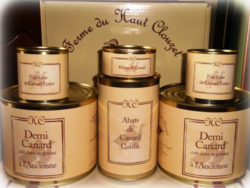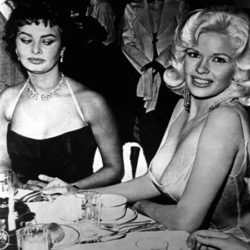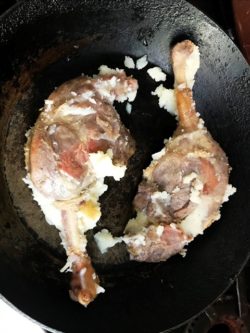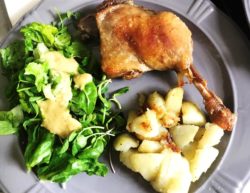Read Time: 5 Minutes Subscribe & Share
A Duck Invasion
 The fact that you now see Confit De Canard, or preserved duck, legs in some grocery stores, usually sold singly and wrapped in plastic – minus the duck fat (which is a shame) that it was cooked in – must mean that another breach has been made by the French in their ongoing attack on American staples. Add this to baguettes, brie, Dijon mustard, French fries, pate, to name just a few. Have not seen the crossover to gas station mini marts yet, but these things take time. We have friends who pick up several duck legs at a time for a quick mid-week meal – fry on both sides, make a salad, heat a baguette, also from said grocery store – and boom you have a meal in 20 minutes.
The fact that you now see Confit De Canard, or preserved duck, legs in some grocery stores, usually sold singly and wrapped in plastic – minus the duck fat (which is a shame) that it was cooked in – must mean that another breach has been made by the French in their ongoing attack on American staples. Add this to baguettes, brie, Dijon mustard, French fries, pate, to name just a few. Have not seen the crossover to gas station mini marts yet, but these things take time. We have friends who pick up several duck legs at a time for a quick mid-week meal – fry on both sides, make a salad, heat a baguette, also from said grocery store – and boom you have a meal in 20 minutes.
Waste Not Want Not
Yet, this delicacy is really simple to make and it’s kind of like having a super savings account in your fridge. You can keep your confit canard or preserved duck preserved for up to six months covered in the fat that it is cooked in. Plus, you have this beautifully flavored duck fat that you save for frying potatoes (or making BLT mayonnaise). If you save the duck fat after making confit de canard, make sure that you strain it, and then allow the duck juices to sink
for up to six months covered in the fat that it is cooked in. Plus, you have this beautifully flavored duck fat that you save for frying potatoes (or making BLT mayonnaise). If you save the duck fat after making confit de canard, make sure that you strain it, and then allow the duck juices to sink  to the bottom of the container in the fridge. Pull up the congealed fat and store it in one container and use the duck drippings to flavor cooked vegetables or pasta.
to the bottom of the container in the fridge. Pull up the congealed fat and store it in one container and use the duck drippings to flavor cooked vegetables or pasta.
You can actually take a whole duck and cut it into pieces and “confit” all of them together, but for some reason it has only been the legs that have made it to our grocery frontiers. And of course, you can use any duck, but the Moulard is probably the most readily available. I was always curious about the moulard (mulard in French) because when I purchased duck breasts, the Moulard variety was more available than Pekin, and they were certainly the Jayne Mansfield of duck breasts. Huge and, contrary to the advertising, not great for duck breast recipes. That said, the avoirdupois moulard breasts, thighs and legs are great for confit.
A Quacker Recap
 Pekin (not Peking)or Long Island duck is smaller, and the meat, particularly the breast meat, is more tender than the Moulard, which is a cross between the Pekin and Barbary or Muscovy duck. The moulard or mulard is a hybrid and cannot reproduce, hence the name that means “mule duck” A mule is a hybrid between a male donkey and a female horse and cannot reproduce.(Just so you know, the reverse hybrid between a male horse and a female donkey is a Hinny.) The moulard/mulard, whose name is also a clever cross between “mule” and “canard”, is larger and meatier, originally raised for foie gras production in France and then on to North America. In fact, all of the foie gras available in this hemisphere is from these ducks. You may also see a Rohan duck in your butcher’s case, which is a proprietary breed of the meat supplier D’Artagnan. It is a cross developed from a Pekin and several types of Mallard ducks. But back to our ducky savings account.
Pekin (not Peking)or Long Island duck is smaller, and the meat, particularly the breast meat, is more tender than the Moulard, which is a cross between the Pekin and Barbary or Muscovy duck. The moulard or mulard is a hybrid and cannot reproduce, hence the name that means “mule duck” A mule is a hybrid between a male donkey and a female horse and cannot reproduce.(Just so you know, the reverse hybrid between a male horse and a female donkey is a Hinny.) The moulard/mulard, whose name is also a clever cross between “mule” and “canard”, is larger and meatier, originally raised for foie gras production in France and then on to North America. In fact, all of the foie gras available in this hemisphere is from these ducks. You may also see a Rohan duck in your butcher’s case, which is a proprietary breed of the meat supplier D’Artagnan. It is a cross developed from a Pekin and several types of Mallard ducks. But back to our ducky savings account.
Confit Advice
I have followed the methods of Madeleine Kamman and Thomas Keller with the most success. Several things are important: 
Really trim all the excess fat you can off each piece (but not the skin!) and cut into small pieces (1/2 inch approximately). Put them into a frypan over low heat (we recommend the Mineral B Pro fry pan from our friends at de Buyer) and allow the fat to melt off, as you will use this as part of the fat in making the confit. I save the the little crispy bits, salt them lightly and use them reheated in pasta and salads. I don’t cut the ends off the legs either, as that seems to be a decorative touch rather than a practical one. It is important to weigh out your duck pieces because you don’t want more than 1/3 ounce of herbed salt for each pound of duck meat.
Don’t let the duck pieces sit in the herbed salt mixture for more than 24 hours – I think the salt and herbs start to overwhelm the duck’s flavor after 24 hours.. Also make sure that each piece is rinsed and dried thoroughly before laying them into your pot.
I don’t add garlic to the herbed mixture, but rather slice a head of garlic in half crosswise and add it to the fat. Madeleine Kamman had a really tasty spice combination, but I also like Thomas Keller’s green herb version. Add whatever duck fat you have been able to render to the amount you have purchased. You will need to have enough duck fat to cover the pieces by at least 1 inch or 2cm.
I cannot get my oven temperature low enough (190F) to keep the poaching fat between 185-195F (a Thermapen is your best friend here) so it is easier for me to cook the duck on top of the stove. Maintaining this temperature range will guarantee you a non-stringy and non-leathery duck confit, which is my main complaint about the versions you get in restaurants. Madeleine Kamman’s recipe calls for about 2 1/2 hours, and Thomas Keller’s takes 8 to 10 hours! I was happy with the results after four hours.
Here are the proportions for Madeleine Kamman’s confit spice mixture, which is a nice rub for pork too. These are the proportions for six duck legs, but I have made this combination in a larger amount to have on hand as a dry rub for piggy.
1/2 teaspoon each of ground cumin, ground coriander, cinnamon, allspice, ginger
1/4 teaspoon freshly ground nutmeg and finely crumbled dried thyme
1/8 teaspoon ground cloves and 1 Turkish bay leaf, finely crumbled


- 1/2 cup sea salt (144gr) - I have used both fine and coarse
- 2 tablespoons (28gr) Light Muscavado Sugar ( I recommend India Tree)
- 2 bay leaves, crumbled into large pieces
- 2 tablespoons (6gr) chopped fresh thyme
- 1/4 cup (26gr) flat parsley leaves (a little bit of stems is fine)
- 1 teaspoon (2-3gr) black peppercorns
- 6-8 duck thigh and leg pieces or 4 breast halves and 2 thigh/leg pieces.
- 6-8 cups(1.5lt-2lt) rendered duck fat, at room temperature on the day of cooking.
- Combine the salt, sugar, bay leaves, thyme and peppercorns in a small food processor and pulse until your have a rough mixture (not a puree).
- Pull or cut away as much excess fat from each piece of duck (not the skin) and cut the fat into 1/2 inch pieices- this makes it easier to render the fat in a frypan, and you will of course save the fat.
- Rub the herbed salt over each piece - on both sides - remembering that you have weighed the duck pieces and measured 1/3 oz (approximately 2 tablespoons) for each pound of duck meat.
- Put the pieces, flesh side up, in a single layer in a pan, cover with cling wrap, and refrigerate for no more than 24 hours.
- If you can get an oven temperature of around 190F, you can then proceed by poaching the duck pieces in their fat, but you must check the temperature so that it does not go above 195F.
- Rinse and dry each duck piece thoroughly, and layer them in a casserole, but no more than two deep.
- Pour the melted duck fat over the duck pieces, ( i always add a whole head of garlic, sliced in half crosswise, but Keller does not). Cover the pot and proceed to cook either on top of your stove or in your oven.
- He cooks it for 8 to 10 hours but I stop at around 4 hours.
- Allow the pieces to cool in the duck fat, and then transfer to container, covering them completely with the duck fat. (I strain it).
- The remaining duck fat should be strained into another container - when it congeals, duck juices should sink to the bottom so that the pure fat can be stored and used again.
- When ready to serve, allow them to come somewhat to room temperature and remove the required pieces (he microwaves the container just to get the fat soft enough to easily remove the duck).
- You can bake them in a 350F preheated oven or saute them on top of the stove, skin side down over medium heat until lightly browned and then turn over to cook them a bit on the flesh side.

Kitchen Detail shares under the radar recipes, explores the art of cooking, the stories behind food, and the tools that bring it all together, while uncovering the social, political, and environmental truths that shape our culinary world.




Comments are closed here.
Follow this link to create a Kitchen Detail account so that you can leave comments!